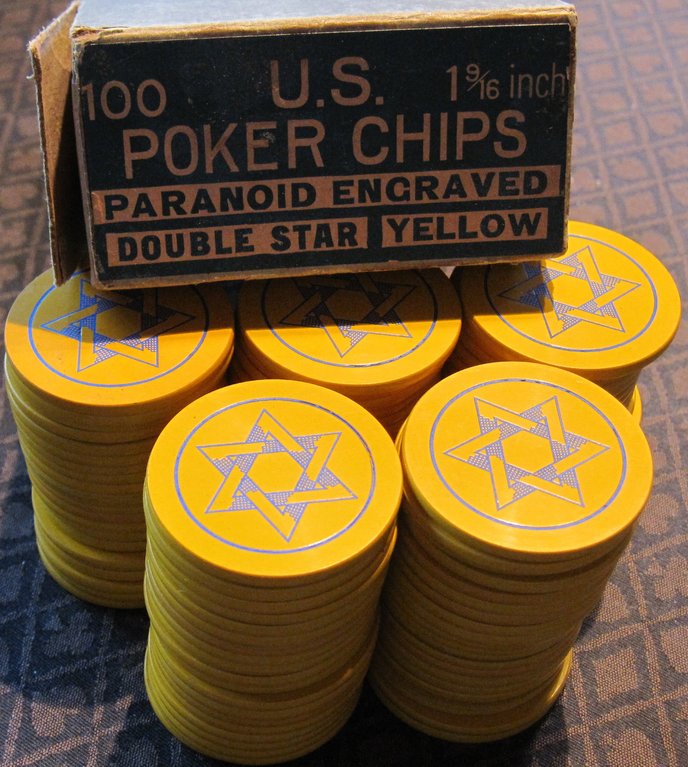As
@Brookston said, those sorts of chips are known as "Paranoid" chips. Paranoid might be the brand name of the material that they were made out of, or it might be the brand name of the chips themselves - I've seen claims made that it's the material, but I haven't seen a good source to back up those claims.
More generally, they're compression-molded inlaid chips with die-cut inlays: complex shapes cut out from a single piece of colored material, as opposed to circular inlays with a full-color printed design. Chips of this type were manufactured by the US Playing Card Company, and possibly some other competitors or successors (such as the Burt Company) but I'm not certain about that. USPCC and Burt manufactured chips that were sold by many different distributors and retailers under their own name, including Mason & Co. These kinds of compression-molded inlaid chips are the forerunners of the modern casino clay chips we know and love.
They were made featuring a wide variety of symbols. Some of the most common seem to be Crescent Moon and Star, Fleur de Lis, Iron Cross, Clover/Shamrock, and of course letters for people's initials. Here's a couple of examples from early advertisements:
View attachment 531651
View attachment 531665
I don't know how well we can pin down the dates of manufacture beyond "early to mid 20th century". I suspect they stopped being made about the time that Paulson, Burt, and TR King started making modern, edge-molded, printed inlay chips for legalized casinos in Nevada. I think that was roughly post-WWII era. I'm guessing here. We could know better by reviewing sales and marketing materials from the chip makers over the years; I know some people have done that, but I don't know what conclusions they've drawn about Paranoid chips, if any.
Paranoid chips come up for sale on
eBay all the time, but almost always in small lots - ones and twos, dozens, almost always less than a hundred. Quantities that make for playable poker sets - two to four hundred - come up maybe once a month or so. I've never seen a complete roulette set like yours before.
I'd encourage you to take your time selling your set. It will probably take a while to establish a fair market value. Large and complete sets like yours are uncommon, but the number of interested buyers is also probably quite small. You might be able to get a very good price per chip by dribbling them out in ones and twos, but that could take years to sell the whole set (and in my opinion it would be an absolute shame to break up the set like that). Also, I'm not at all convinced that the people advertising single chips for several dollars are actually seeing any sales; I think they just keep the same chips up on
eBay forever.
Here are some listings I've seen for playable poker sets of these types of chips. Perhaps you can use these to help establish a value for your set:
https://www.ebay.com/itm/Vintage-Clay-Poker-Chips-with-Wood-Caddy-and-Box-/124312255992
https://www.ebay.com/itm/Vintage-Ba...w-Solid-Hardwood-Caddy-184-Chips/383257059551
https://www.ebay.com/itm/Antique-IN...chip-set-with-caddy-1890s-1900s-/164063364223
https://www.ebay.com/itm/Antique-Vi...ard-Box-Gambling-Wimbledon-Cards/193320890290
https://www.ebay.com/itm/300-Vintage-Clay-Poker-Chips-in-Original-Box-Tray-/313108536679
https://www.etsy.com/listing/660444296/vintage-clay-casino-pokerchips-antique
Searching for "Paranoid poker chips" won't turn up much. You can instead search for "inlaid poker chips" or "vintage poker chips" and you'll usually see plenty of them, mostly in small quanties per lot.
Good luck with your efforts! If you do decide to sell them, please post something on PCF to let us know about it. You might find an eager buyer here.






